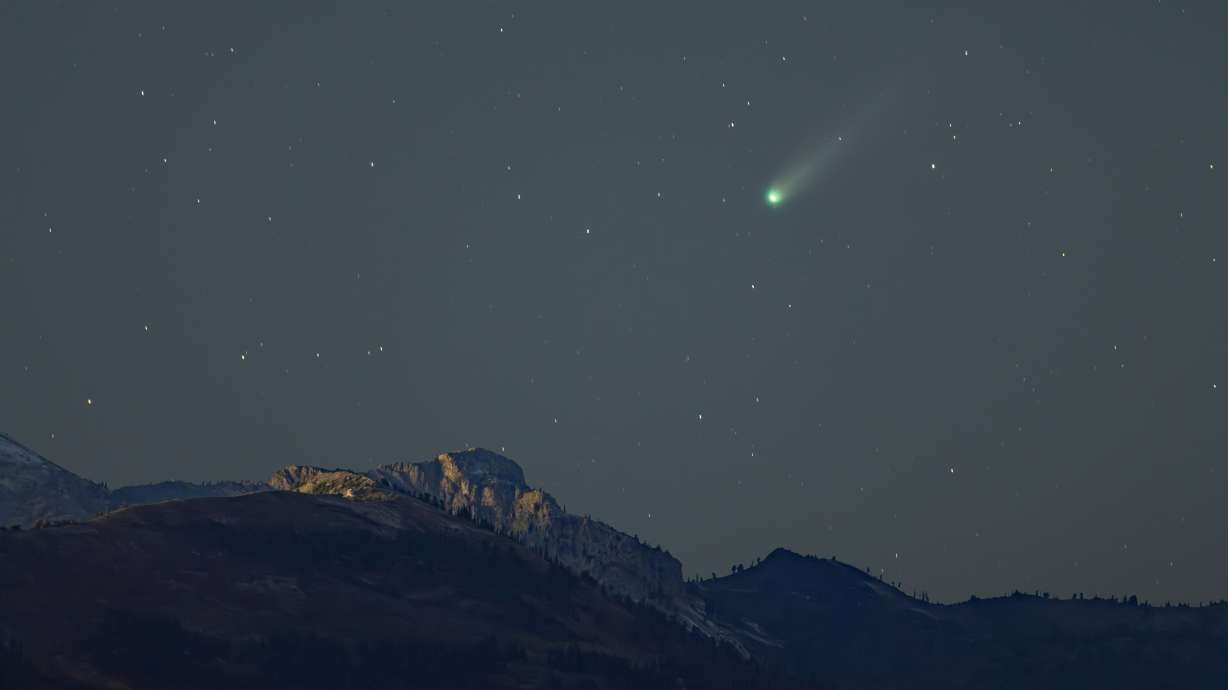SALT LAKE CITY — With October’s Harvest Moon having passed us by, and November’s Beaver Moon still a couple of weeks away, two new comets are peaking through the evening sky, giving stargazers something interesting to view this month.
Comet C/2025 A6 — also known as Lemmon — will make its closest approach to Earth on Tuesday night, Oct. 21, and will continue to brighten as it travels toward the sun. For the next several weeks, should the comet remain intact, it will remain visible in the evening sky, even detectable with the unaided eye in darker skies.
Comet C/2025 R2 — which prefers the name SWAN — also has passed its closest point to Earth this week, and though fainter than Lemmon, can also be spotted in the western sky after sunset.
Both comets are best viewed with binoculars or small telescopes.
The news of these two comets should be measured against past comet behavior. Utah’s NASA/JPL Solar System ambassador Patrick Wiggins’ stock response when it comes to comets is that, just like cats, “they have tails and do what they want!” It’s a comment that stresses the fickleness of this type of astronomical event.
However, Jenette Scott, vice president of the Salt Lake Astronomical Society, said both comets should make a good showing this month.
“Together, these two comets will make autumn 2025 a memorable season for skywatchers,” she said.
And since the new moon is conveniently missing from the night sky on Tuesday night, as Scientific American points out, it’s a great opportunity to try and spot these comets, Lemmon in particular.
How to observe comet Lemmon
Wiggins said to see Lemmon, one must move away from city lights. Viewing from a dark sky will give the best chance of seeing Lemmon with an unaided eye, Scott said.
It will be visible Tuesday night in the constellation Boötes, she said. This constellation will be above the northwestern horizon after sunset, so try to at least avoid city lights in that part of the sky. It should be visible about 90 minutes after sunset, which will be 6:37 p.m. in Salt Lake City, according to timeanddate.com.
Since Lemmon is very faint, even in a dark sky, it will not be obvious to see without using the stars around it as a reference. Locate the handle of the Big Dipper, which will lie above the northwest horizon. Following the handle in a downward arc should direct your gaze to a bright star called Arcturus, which is the brightest star in the Boötes constellation.
If you’ve gotten this far, you’ve successfully “arced to Arcturus,” a textbook maneuver for novice stargazers. Boötes is a large constellation, which also resembles a kite — Arcturus being at the base. Following star maps provided by Scientific American or other online sources, you will find Lemmon above Arcturus, between the two bright stars in the middle of the constellation.
Again, on Tuesday night, Lemmon will be just bright enough to make out faintly with your naked eye. Both Scott and Wiggins said to use binoculars to get the best view of the comet. Just look in the direction you want to view in the binoculars, then bring them up to your face. iPhones or similar devices will detect a small smudge in the sky if you hold them still enough. That smudge is comet Lemmon.
If you cannot see Lemmon on Tuesday night, it will appear again on subsequent nights, only having moved further south along the sky, as can be seen in earthsky.org’s star charts.
What to expect to see
You will know you have spotted Lemmon in your binoculars or other optical device when you find a “faint, fuzzy green patch,” Scott said.
While earthsky.org writes Lemmon might be “the best comet of 2025,” Wiggins said to be careful not to expect more than a smudge with the “hint of a tail.”
Scott said the tail of the comet may be spotted with the naked eye, though Lemmon currently does not appear to have as long a tail as last year’s Tsuchinshan-ATLAS, or Neowise in 2020 — but it does have a green hue. Scott explains that the coloration is caused by UV rays from the sun reacting with the comet’s coma, which is composed of a particular flavor of carbon gas, in just the right way to give it this distinct color.
Wiggins said not to expect to see anything resembling images from observatories or astrophotographers online. The classic expectation when comets are announced, the ambassador said, is to see a spectacle on the order of Comet Hale-Bopp or Hyakutake, which appeared in the 1990s. In reality, comets are really quite common; the bright ones are not, he said.
How long Lemmon and SWAN will be visible
While Lemmon is on a 1,350-year circuit around the solar system, and SWAN completes its orbit once every 640 years, you have some time to see these two comets before they disappear, virtually forever, Scott said.
There will be roughly 24 nights that Lemmon should be visible, until it sets below the horizon on Nov. 12. The astronomer said it should get brighter each night, reaching its brightest around Oct. 31. It will then appear lower on the horizon until Nov. 8, when it will be harder to spot through the thicker atmosphere.
Comet SWAN reached its nearest point to Earth on Oct. 20, Scott said, and can be found low in the western sky after sunset, in the constellation Scutum. Scott noted its peak brightness will only be just bright enough to see unaided in dark skies; Wiggins is not as hopeful for SWAN as he is Lemmon. SWAN will also appear a bluish-green color, being composed of the same compounds as Lemmon.
The Key Takeaways for this article were generated with the assistance of large language models and reviewed by our editorial team. The article, itself, is solely human-written.
First Appeared on
Source link













